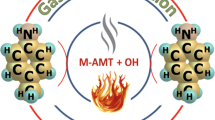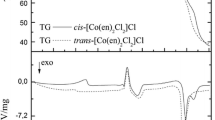Abstract
The thermal behaviours of alkylammonium and potassium N-alkylthiocarbamates of general formula (RNH3) (RHNCXY) (where X= Y= S or X= S and Y= 0; R=n-C3H3,i-C3H3,n-C4H9,i-C4H9 orc-C6H11) and K(RHNCOS) (where R=CH3, C2H5,n-C3H7,i-C3H7,n-C4H9,i-C4H9 orc-C6H11) were investigated. The decomposition mechanisms exhibit a similar character for all studied compounds. In the course of thermolysis symmetric dialkylureas and dialkylthioureas, as well as amines, CS2 (or COS) and H2S are formed. The alkylammonium thiocarbamates decompose without any residue, whereas with potassium monothiocarbamates potassium sulfate is left as a residue. For the process of urea and thiourea formation during the first step of decomposition, the activation energies were computed for some compounds.
Résumé
On a étudié le comportement thermique des N-alcoyl-thiocarbamates d'ammonium et de potassium de composition (RNH3) (RHNCXY), avec X=Y=S ou X=S et Y=O; R=n-C3H7,i-C3H7,n-C4H9,i-C4H9,c-C6H11 ainsi que des composés K(RHNCOS) avec R=CH3, C2H5,n-C3H7,i-C3H7,n-C4H9,i-C4H9,c-C6H11. Les mécanismes de décomposition montrent un caractère similaire pour tous les composés. Au cours de la thermolyse il se forme des dialcoylcarbamides symétriques ou des thiocarbamides ainsi que des amines, CS2 (ou COS) et H2S. Alors que les alcoylthiocarbamates d'ammonium se décomposent sans résidu, les monothiocarbamates de potassium donnent du sulfate de potassium comme résidu. On a calculé les énergies d'activation pour la réaction de formation de la carbamide ou de la thiocarbamide pendant la première étape de la décomposition des alcoylthiocarbamates d'ammonium.
Zusammenfassung
Es wurde das thermische Verhalten von Alkylammonium- und Kalium-N-alkylthiocarbamaten der Zusammensetzung (RNH3) (RHNCXY) mit X=Y=S oder X= S und Y= 0; R=n-C3H7,i-C3H7,n-C4H9,i-C4H9,c-C6H11 bzw. K(RHNCOS) mit R= CH3 C2H5,n-C3H7,i-C3H7,n-C4H9,i-C4H9,c-C6H11 untersucht. Die Zersetzungsmechanismen zeigen bei allen untersuchten Verbindungen einen ähnlichen Charakter. Im Verlaufe der Thermolyse entstehen symmetrische Dialkylharn- bzw. -thioharnstoffe sowie Aminé, CS2 (bzw. COS) und H2S. Während sich die Alkylammoniumthiocarbamate ohne Rückstand zersetzen, verbleibt bei den Kaliummonothiocarbamaten Kaliumsulfat als Rückstand. Für den Prozeß der Harn- bzw. Thioharnstoffbildung während der ersten Abbaustufe der Alkylammoniumthiocarbamate wurden die Aktivierungsenergien berechnet.
Резюме
Исследовано термиче ское поведение солей N-алкалитиокарбамато в алкалиммония и калия общей формулы (RNH3) ((RHNCXY), где X=.Y=S или X=S и Y=О; R=н-С3Н7, изо-С3Н7, н-C4H9, изо-С4Н9, цикло-С6Н11 и K(RHNCOS) c R=СН3, С2Н5, н-С3Н7, изо-C3H7, н-С4Н9, изo-C4H9 и цикло-С6Н11. Для всех изученных соеди нений установлен подобный механизм ра зложения. Во время тер молиза получаются как симме тричные диалкилпроизводные мочевины и: тиомочеви ны так и амины, CS2 (соответствен но COS) и H2S. В то время как алкил аммониевые соли монотиокарбаматов р азлагаются без каког олибо остатка, монотиокарб аматы калия образуют в качестве остатка сульфат кали я. В процессе образован ия мочевины и тиомоче вины на первой стадии разлож ения, были вычислены энергии ак тивации для некоторы х соединений.
Similar content being viewed by others
Literatur
A. Klemenc, Z. Anorg. Allgem. Chem., 191 (1930) 246; Z. Elektrochem. Angew. Physik. Chem., 36 (1930) 799; DRP 537 765, 12. 11. 1931.
G. J. M. van der Kerk, H. G. J. Overmars undG. M. van der Want, Rec. Trav. Chim., Pays-Bas, 74 (1955) 1301.
R. A.Franz, USP 2 681 930, 22. 6. 1954.
E.Glanzstoff-AG, BRD-AS 2 015 010, 25. 11. 1971.
M.Mortag, Dissertation, Mühlhausen 1979.
W. Müller-Litz undD. Thomzik, J. Prakt. Chem., 319 (1977) 677.
W.Müller-Litz und D.Thomzik, Z. Chem., (in Vorbereitung).
H. H. Horowitz undG. Metzger, Anal. Chem., 35 (1963) 1464.
P. M. Madhusudanan, K. K. Mohammed Yusuff undC. G. Ramachandran Nair, J. Thermal. Anal., 8 (1975) 31.
Author information
Authors and Affiliations
Rights and permissions
About this article
Cite this article
Müller-Litz, W., Mortag, M. Zum Thermischen Verhalten von Alkylammonium- und Kalium-N-Alkylthiocarbamaten. Journal of Thermal Analysis 18, 137–145 (1980). https://doi.org/10.1007/BF01909461
Received:
Issue Date:
DOI: https://doi.org/10.1007/BF01909461




